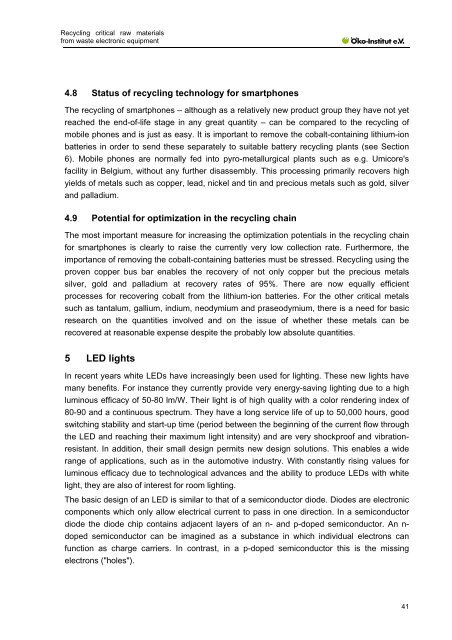Recycling critical raw materials from waste electronic equipment
Recycling critical raw materials from waste electronic equipment
Recycling critical raw materials from waste electronic equipment
You also want an ePaper? Increase the reach of your titles
YUMPU automatically turns print PDFs into web optimized ePapers that Google loves.
<strong>Recycling</strong> <strong>critical</strong> <strong>raw</strong> <strong>materials</strong><br />
<strong>from</strong> <strong>waste</strong> <strong>electronic</strong> <strong>equipment</strong><br />
4.8 Status of recycling technology for smartphones<br />
The recycling of smartphones – although as a relatively new product group they have not yet<br />
reached the end-of-life stage in any great quantity – can be compared to the recycling of<br />
mobile phones and is just as easy. It is important to remove the cobalt-containing lithium-ion<br />
batteries in order to send these separately to suitable battery recycling plants (see Section<br />
6). Mobile phones are normally fed into pyro-metallurgical plants such as e.g. Umicore's<br />
facility in Belgium, without any further disassembly. This processing primarily recovers high<br />
yields of metals such as copper, lead, nickel and tin and precious metals such as gold, silver<br />
and palladium.<br />
4.9 Potential for optimization in the recycling chain<br />
The most important measure for increasing the optimization potentials in the recycling chain<br />
for smartphones is clearly to raise the currently very low collection rate. Furthermore, the<br />
importance of removing the cobalt-containing batteries must be stressed. <strong>Recycling</strong> using the<br />
proven copper bus bar enables the recovery of not only copper but the precious metals<br />
silver, gold and palladium at recovery rates of 95%. There are now equally efficient<br />
processes for recovering cobalt <strong>from</strong> the lithium-ion batteries. For the other <strong>critical</strong> metals<br />
such as tantalum, gallium, indium, neodymium and praseodymium, there is a need for basic<br />
research on the quantities involved and on the issue of whether these metals can be<br />
recovered at reasonable expense despite the probably low absolute quantities.<br />
5 LED lights<br />
In recent years white LEDs have increasingly been used for lighting. These new lights have<br />
many benefits. For instance they currently provide very energy-saving lighting due to a high<br />
luminous efficacy of 50-80 lm/W. Their light is of high quality with a color rendering index of<br />
80-90 and a continuous spectrum. They have a long service life of up to 50,000 hours, good<br />
switching stability and start-up time (period between the beginning of the current flow through<br />
the LED and reaching their maximum light intensity) and are very shockproof and vibrationresistant.<br />
In addition, their small design permits new design solutions. This enables a wide<br />
range of applications, such as in the automotive industry. With constantly rising values for<br />
luminous efficacy due to technological advances and the ability to produce LEDs with white<br />
light, they are also of interest for room lighting.<br />
The basic design of an LED is similar to that of a semiconductor diode. Diodes are <strong>electronic</strong><br />
components which only allow electrical current to pass in one direction. In a semiconductor<br />
diode the diode chip contains adjacent layers of an n- and p-doped semiconductor. An ndoped<br />
semiconductor can be imagined as a substance in which individual electrons can<br />
function as charge carriers. In contrast, in a p-doped semiconductor this is the missing<br />
electrons ("holes").<br />
41

















